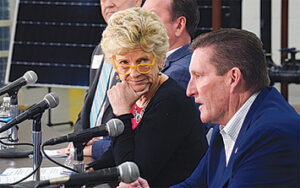
By TIM ROWDEN
Managing Editor
Earth City, MO – U.S. General Services Administration (GSA) Administrator Robin Carnahan visited Plumbers & Pipefitters Local 562’s training center last week to discuss the Bipartisan Infrastructure Law and other Biden-Harris administration efforts to create good-paying union jobs by investing in federal facilities and infrastructure.
“It is really fun for me to be back with so many friends here in St. Louis who have spent their lives trying to help working families and build their communities,” Carnahan said. “Politicians like to talk about infrastructure; they talk about it all the time, but they don’t always do much about it. To finally have serious investments in the kind of infrastructure we’ve been talking about for years is a very big deal.”
LOCAL PROJECTS
In Missouri alone, the Bipartisan Infrastructure Law include investments of:
- $7 billion to upgrade highways and bridges.
- Over $670 million for public transit.
- $250 million for airports.
- $100 million for electric vehicle (EV) charging stations.
- $100 million for broadband coverage, especially for those who don’t have good access now.
- $860 billion for water infrastructure, including replacing lead pipes.
In Illinois, the infrastructure law includes:
- $11.2 billion to upgrade highways and bridges.
- $4 billion for public transit.
- $149 million for expansion of EV charging stations.
- $100 million for broadband coverage.
President Biden’s fiscal year 2023 budget request also includes $10.9 billion for critical repairs and renovations of federal buildings.
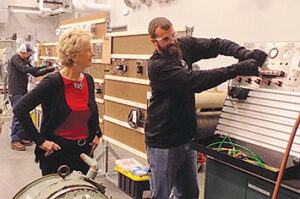
ONCE IN A GENERATION INVESTMENTS
“These are once-in-a-generation investments in America’s roads, bridges, rail, airports, ports and public transit as well as expanding access to safe drinking water and high-speed internet and addressing the climate crisis,” Carnahan said.
“And when we make these investments, we’re also committed to making sure we get the best value for taxpayer dollars. The President’s executive order calling for Project Labor Agreements on major federal construction projects will help make sure these projects are completed on time, on budget, and with workers getting the fair wages and benefits they deserve.”
Carnahan toured Local 562’s training center and spoke individually with some apprentices before sitting down for the roundtable.
“It’s one thing to pass a bill, it’s another thing to make that a reality so that it actually affects people’s lives and improves people’s lives,” Carnahan said. “That’s where job training facilities like this come in, because in order to actually make this real, it takes a lot of hard work, and it takes a lot of highly skilled workers. The work that you all are doing is going to be what makes these investments real.”
KEEPING UP-TO-DATE ON NEW TECHNOLOGY
Pat Kellett, general secretary-treasurer of the United Association of Plumbers, Fitters, Welders and Service Techs (UA) and former business manager of Local 562, said apprentice training and continuing education of journeymen, like that provided at the Local 562 Training Center, ensure union workers are trained for the older, current and emerging technologies they will encounter on the job.
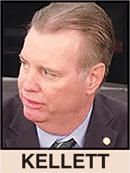 “A lot of safety regulations and technology are changing, and we’ve kept up with it,” Kellett said. “We keep our members up-to-date on the new technology and you don’t do that without schools like this.”
“A lot of safety regulations and technology are changing, and we’ve kept up with it,” Kellett said. “We keep our members up-to-date on the new technology and you don’t do that without schools like this.”
Kellett said the building trades spend $2.5 billion a year on education at no cost to taxpayers.
“In the UA, it’s about $220 million annually that our contractors and unions negotiate. There’s no federal money in that. There’s no state money in that.
“We are staying ahead of the curve with schools like this, with our contractors’ associations and our vendors who stay at the forefront of the new technologies that are coming out and share them with us, and we bring it to our apprentices as well as journeymen,” Kellett said.
“Our journeymen training goes on day-in and day-out.”
TRAINING FOR TOMORROW
Today’s technology, and the skills required to work with it, is radically different from what it was a few decades ago, Local 562 Business Manager John O’Mara said.
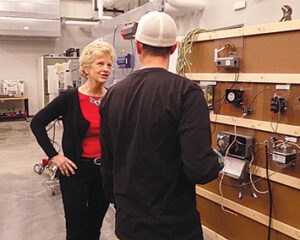
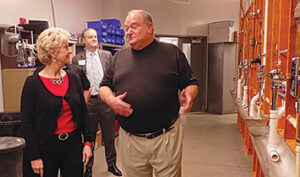
“The main thing we’re focused on in this training center is what does the future look like,” O’Mara said. “Even the water systems and the sewer systems, the technology in them is way different than it was 50 years ago. We’re replacing old systems. We’re out right now replacing lead lines that are going to houses.
“This building was built for one reason,” O’Mara said. “It was built for the community, it was built for the region, so that everybody has the opportunity to come here and learn pipefitting. We’re proud of our apprentice program. This facility’s hands-on aspects brings us to a whole different level of efficiency.”
 David Beard, general vice president of the Ironworkers and former business manager/secretary-treasurer of Ironworkers Local 392, told Carnahan the technologies and skills that people need and are using today were taught in union training centers five years ago.
David Beard, general vice president of the Ironworkers and former business manager/secretary-treasurer of Ironworkers Local 392, told Carnahan the technologies and skills that people need and are using today were taught in union training centers five years ago.
“I would say every one of the building trades’ educational departments are looking to the future, planning for new technology, and changing their curriculum on an ongoing basis so our workers are ready,” Beard said.
CONTINUOUS TRAINING
Emily Martin, president of Aschinger Electric and the St. Louis Chapter of the National Electrical Contractors Association (NECA), said continuous training is key.
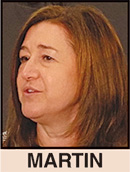 “Every apprentice that goes through our program (IBEW/NECA Electrical Industry Training Center) is being trained in the electric vehicle charging stations so that when they graduate from the apprenticeship, they will have their certification and they will know how to do those installations,” Martin said. “We’re trying to make sure that our training is preparing our workforce to be ready to install those technologies as the market is coming.”
“Every apprentice that goes through our program (IBEW/NECA Electrical Industry Training Center) is being trained in the electric vehicle charging stations so that when they graduate from the apprenticeship, they will have their certification and they will know how to do those installations,” Martin said. “We’re trying to make sure that our training is preparing our workforce to be ready to install those technologies as the market is coming.”
MAKING A DIFFERENCE IN WORKERS’ LIVES
John Stiffler, executive secretary-treasurer of the St. Louis Building & Construction Trades Council, said the long-term scope of the work in the federal infrastructure package and President Biden’s executive mandating federally funded construction projects worth at least $35 billion must be built by union workers using Project Labor Agreements will make a huge difference in workers’ lives.
 “That gives a person a chance to purchase their first home, maybe purchase their first automobile, send your children to a good school, send them to a good college and pay their tuition,” Stiffler said.
“That gives a person a chance to purchase their first home, maybe purchase their first automobile, send your children to a good school, send them to a good college and pay their tuition,” Stiffler said.
“Construction has peaks and valleys,” he said.” That the federal government is going to spend all this money building these federal projects, that gives you peace of mind.”


